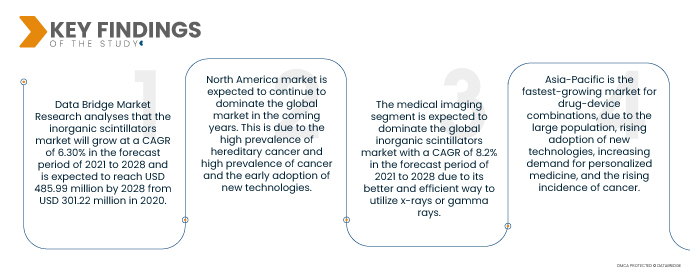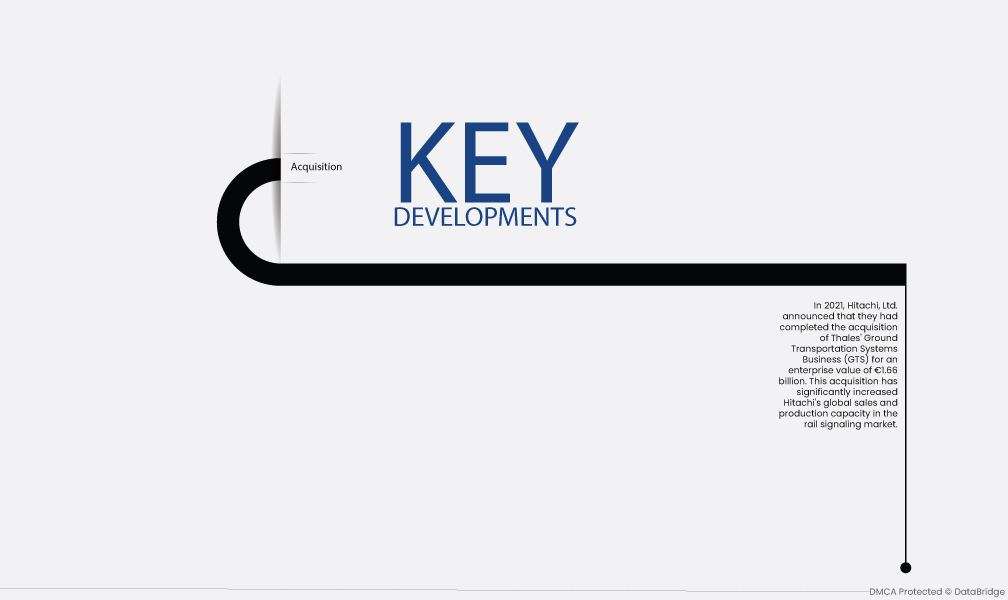Given the increasing threat of nuclear bombs and terrorist strikes, radiation-detecting materials are used for domestic security. As a result, the United States and European governments have increased their security by installing radiation-detecting equipment at numerous ports, railroads, and airports. Emerging economies such as India and China are enhancing their security systems, such as train stations, ports, and airports, by incorporating radiation detection equipment. Over the forecast period, emerging markets are likely to represent high-potential markets.
Access Full Report @ https://www.databridgemarketresearch.com/reports/global-inorganic-scintillators-market
Data Bridge Market Research analyses that the Inorganic Scintillators Market will grow at a CAGR of 6.30% in the forecast period of 2021 to 2028 and is expected to reach USD 485.99 million by 2028 from USD 301.22 million in 2020. There is a constant research and development effort to develop new scintillator materials with improved properties, such as higher light yield, faster response time, and better energy resolution. Inorganic scintillators are increasingly being used in non-medical applications, such as industrial safety, homeland security, and environmental monitoring. Portable and handheld scintillation detectors are becoming increasingly popular, as they offer a convenient and cost-effective way to detect radiation.
Growing demand for medical imaging is expected to drive the market's growth rate
Inorganic scintillators are used in various medical imaging applications, including X-ray imaging, computed tomography (CT), and positron emission tomography (PET). The increasing demand for these imaging procedures is driving the growth of the inorganic scintillators market. Nuclear medicine is a medical specialty that uses radioactive materials to diagnose and treat diseases. Inorganic scintillators are used in a variety of nuclear medicine applications, including gamma cameras, PET scanners, and brachytherapy sources. The growing use of nuclear medicine is also driving the growth of the inorganic scintillators market. Inorganic scintillators are used in a variety of homeland security applications, including radiation detection, nuclear safeguards, and explosive detection. The increasing need for homeland security is also driving the growth of the inorganic scintillators market.
Report Scope and Market Segmentation
|
Report Metric
|
Details
|
|
Forecast Period
|
2021 to 2028
|
|
Base Year
|
2020
|
|
Historic Years
|
2019 (Customizable to 2013- 2018)
|
|
Quantitative Units
|
Revenue in USD Million, Volumes in Units, Pricing in USD
|
|
Segments Covered
|
Scintillation Material (Sodium Iodide (NAI), Cesium Iodide (CSI), Lutetium Oxyorthosilicate (LSO) and Lutetium–Yttrium Oxyorthosilicate (LYSO), Bismuth Germanate (BGO), Barium Fluoride, Lead Tungstate (PBWO4), Cadmium Tungstate (CDWO4), Cerium Bromide (CEBR3), Lanthanum Bromide (LABR3), Gadolinium Orthosilicate (GSO), Yttrium Aluminum Garnet YAG (CE), Gadolinium Oxysulfide (GOS) and Other Scintillation Materials.), Type (Alkali Halides, Oxide Compounds, and Rare Earth Metals), Application (Medical Imaging, Nuclear Medicine, Radioprotection, Oil Exploration, Process Industry, Life Sciences, and Others), End User (Healthcare, Homeland Security and Defense, Nuclear Power Plants, Industrial Applications and Others)
|
|
Countries Covered
|
U.S., Canada and Mexico in North America, Germany, France, U.K., Netherlands, Switzerland, Belgium, Russia, Italy, Spain, Turkey, Rest of Europe in Europe, China, Japan, India, South Korea, Singapore, Malaysia, Australia, Thailand, Indonesia, Philippines, Rest of Asia-Pacific (APAC) in the Asia-Pacific (APAC), Saudi Arabia, U.A.E, South Africa, Egypt, Israel, Rest of Middle East and Africa (MEA) as a part of Middle East and Africa (MEA), Brazil, Argentina and Rest of South America as part of South America
|
|
Market Players Covered
|
Saint-Gobain (France), Dynasil Corporation (U.S.), Hitachi Ltd (Japan), TOSHIBA MATERIALS CO., LTD.(China), Epic Crystal (China), NIHON KESSHO KOGAKU CO., LTD (Japan)., Thermo Fisher Scientific, Inc, NUVIA (U,K,), Gammaspectacular (Australia), Alkor Technologies (Russia), Hellma GmbH & Co. KG (Germany), Omega Piezo Technologies (U.S.), Berkeley Nucleonics Corporation (U.S.)
|
|
Data Points Covered in the Report
|
In addition to the market insights such as market value, growth rate, market segments, geographical coverage, market players, and market scenario, the market report curated by the Data Bridge Market Research team includes in-depth expert analysis, patient epidemiology, pipeline analysis, pricing analysis, and regulatory framework
|
Segment Analysis:
Global inorganic scintillators market is categorized into four notable segments which are based on the scintillation material, type, application and end user.
- On the basis of scintillation material, the global inorganic scintillators market is segmented into sodium iodide (NAI), cesium iodide (CSI), lutetium oxyorthosilicate (LSO) & lutetium–yttrium oxyorthosilicate (LYSO), bismuth germanate (BGO), barium fluoride, lead tungstate (PBWO4), cadmium tungstate (CDWO4), cerium bromide (CEBR3), lanthanum bromide (LABR3), gadolinium orthosilicate (GSO), yttrium aluminum garnet YAG (CE), gadolinium oxysulfide (GOS) and other scintillation materials.
The sodium iodide (NAI) segment of scintillation material type is anticipated to dominate the inorganic scintillators market
The sodium iodide (NAI) segment is expected to dominate the global inorganic scintillators market with a CAGR of 7.6% in the forecast period of 2021 to 2028 as it has an unusually large light yield corresponding to a scintillation efficiency of about 13% which gives exact results.
- On the basis of type, the global inorganic scintillators market is segmented into alkali halides, oxide compounds and rare earth metals.
The alkali halides segment of type is anticipated to dominate the inorganic scintillators market
The alkali halides segment is expected to dominate the global inorganic scintillators market with a CAGR of 6.8% in the forecast period of 2021 to 2028 as it has the most pure activity property and detect neutrons easily.
- On the basis of application, the global inorganic scintillators market is segmented into medical imaging, nuclear medicine, radioprotection, oil exploration, process industry, life sciences and others. The medical imaging segment is expected to dominate the global inorganic scintillators market with a CAGR of 8.2% in the forecast period of 2021 to 2028 due to its better and efficient way to utilize x-rays or gamma rays.
- On the basis of end user, the global inorganic scintillators market is segmented into healthcare, homeland security and defense, nuclear power plants, industrial applications and others. The healthcare segment is expected to dominate the global inorganic scintillators market with a CAGR of 6.5% from 2021 to 2028 because of the growing demand for inorganic scintillators in healthcare equipment.
Major Players
Data Bridge Market Research recognizes the following companies as the major market players: Medtronic (Ireland), Zimmer Biomet (U.S.), Amgen Inc. (U.S.), Mediprint (U.S.), Propeller Health (U.S.), B.D. (U.S.), YPSOMED (Switzerland), Vaxess Technologies Inc. (U.S.), Subcuject Aps (Denmark), OcuMedic (U.S.), GlaxoSmithKline plc (U.K.), Bayer AG (Germany), NanoPass (Israel), Sensirion AG (Switzerland), Janssen Pharmaceuticals, Inc. (U.S.), Insulet Corporation (U.S.), Otsuka America Pharmaceutical, Inc. (U.S.), and CGbio (South Korea).
Market Development
- In 2021, Hitachi, Ltd. announced that they had completed the acquisition of Thales' Ground Transportation Systems Business (GTS) for an enterprise value of €1.66 billion. This acquisition has significantly increased Hitachi's global sales and production capacity in the rail signaling market. GTS is a leading provider of rail signaling and train control systems, with a strong presence in Europe, North America, and Asia. The acquisition of GTS has given
Hitachi a significant foothold in the global rail signaling market, and has positioned the company as a leading player in this growing market. Hitachi has stated that the acquisition of GTS will allow them to offer a wider range of rail signaling solutions to customers around the world. The company also expects that the acquisition will help them to accelerate their growth in the rail signaling market. The acquisition of GTS is a major strategic move for Hitachi. The company is looking to expand its presence in the global rail signaling market, and the acquisition of GTS is a significant step towards achieving this goal.
Regional Analysis
Geographically, the countries covered in the market report are U.S., Canada and Mexico in North America, Germany, France, U.K., Netherlands, Switzerland, Belgium, Russia, Italy, Spain, Turkey, Rest of Europe in Europe, China, Japan, India, South Korea, Singapore, Malaysia, Australia, Thailand, Indonesia, Philippines, Rest of Asia-Pacific (APAC) in the Asia-Pacific (APAC), Saudi Arabia, U.A.E, South Africa, Egypt, Israel, Rest of Middle East and Africa (MEA) as a part of Middle East and Africa (MEA), Brazil, Argentina and Rest of South America as part of South America.
As per Data Bridge Market Research analysis:
North America is the dominant region in the inorganic scintillators market during the forecast period 2021-2028
North America is expected to continue to dominate the global market in the coming years due to the high prevalence of chronic cases, well-established healthcare infrastructure, and high prevalence of cancer and the early adoption of new technologies.
Asia-Pacific is estimated to be the fastest-growing region in the inorganic scintillators market in the forecast period 2021-2028
Asia-Pacific is the fastest-growing market for inorganic scintillators, due to the increased investment in the healthcare sector. China is expected to dominate in the market in the Asia-Pacific market. China is one of the leading countries in the world with rapidly increasing product usage and advancement in product development for inorganic scintillators.
For more detailed information about the inorganic scintillators market report, click here – https://www.databridgemarketresearch.com/reports/global-inorganic-scintillators-market












